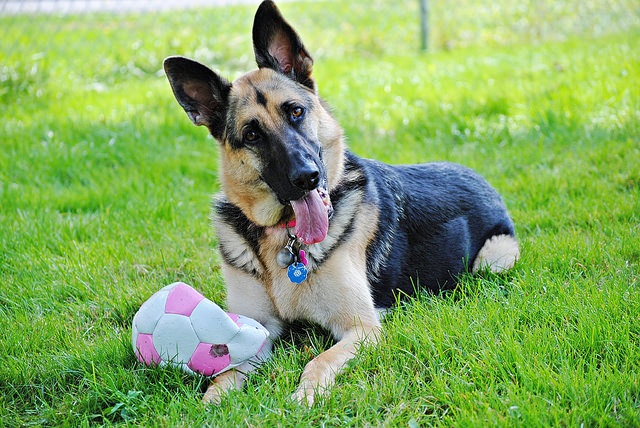One tilt of a dog’s chin and prick of their ears is enough to send a human heartbeat racing with affection. The head tilt is the quintessential “cute dog behavior,” and some dog owners do everything they can, including baby talk and fake cat meows, to bring it out of their pups. Canine behaviorists, scientists, and dog owners delve deeper into the canine psyche to learn more about how dogs think, but the secret behind the head tilt has yet to be officially discovered.
Until the day dogs can speak their minds in a language we understand, we might never know the exact reasoning behind some of their more mysterious behaviors. Experts have, however, been able to speculate based on what they already know about canine anatomy and psychology. Here are the most widely accepted theories about why dogs tilt their heads.

1. To Enhance Hearing
A dog’s sense of hearing is second-best only to their incredible sense of smell. They’re great at watching over the house at night because they can hear sounds too quiet for their human owners to pick up on. Their ears are also designed to detect pitches too high for human ears. This superpower means they have no problem hearing you speak from a few feet away, but the head tilt is thought to be a way to enhance their already powerful sense.
It’s like when you’re traveling with a friend on a crowded subway; it’s noisy and not the best place to have a conversation. When your friend says something, you turn your head to point your ear toward their mouth. You might even use your hand to create a sound tunnel to better hear what they’re saying. A dog tilting their ear toward the source of a sound is a similar strategy for better listening. It also helps them determine exactly where a sound is coming from. Tilting their head helps them establish with better accuracy how far away the sound is. When you’re making cat sounds with your mouth, your dog wants to know if that strange sound is actually coming from you or if there’s a feline intruder somewhere behind you.
2. To See Better
Canine vision doesn’t get the same accolades as a dog’s well-known senses of hearing and smell, but that doesn’t mean their sight should be underestimated. Some dogs, however, see life through a slightly obstructed lens. A professor at the University of British Columbia, Dr. Stanley Coren, theorizes dogs tilt their heads to adjust their lines of vision. With relatively flat faces, humans can look straight ahead and see an unobstructed view. Dogs with long muzzles, however, have the lower half of their vision blocked by their big noses. Dr. Coren believes dogs tilt their heads to get their muzzles out of the way and get a better look at what’s making a sound. He says in Psychology Today,
“We know that dogs continually scan our faces for information and to read our emotional state. Hence it is likely that one reason why dogs may tilt their heads when we talk to them is because they want to see our faces better, and to compensate for the way in which their muzzles obscure part of their vision.”

To test his theory, Dr. Coren conducted a simple survey. He asked 582 dog owners about how often their dogs tilt their heads. Out of those responses, 71% of people who owned dogs with characteristically pronounced muzzles (Collies, Beagles, Greyhounds, etc.) reported their dogs frequently tilt their heads. Only 52% of people with “flat-faced” or brachycephalic dogs could say the same.
Try testing Dr. Coren’s theory yourself by placing your fist at the end of your nose and looking around. You’ll most likely find the lower half of your vision is blocked by your hand.
3. A Sign of Empathy
Dogs have a type of sixth sense when it comes to understanding their people. They’re extremely perceptive, and they can tell when you’re sad, agitated, anxious, and a number of other emotions. Dog people like to talk to their pets, and some dogs make it clear they like to listen. They might not be able to understand every word their human says, but they listen for clues to help them determine what their friend is thinking. They analyze a person’s speech based on tone of voice, body language, how fast they’re talking, and facial expressions. And every now and then, humans throw in words dogs definitely understand like “treat,” “walk,” and “dinner.”
Some behaviorists speculate a head tilt is a dog’s way of contributing to conversation. Like a person shrugging their shoulders or nodding their head, a tilt of the head could be a dog’s way of telling their companion that they’re indeed listening to what’s being said. They’re doing their best to understand what’s going on and offering their support and empathy at the same time. Dogster points out,
“It’s been suggested that dogs who are accustomed to being treated lovingly tilt their heads far more frequently than dogs who have been neglected, abused, or not properly socialized.”
4. A Learned Behavior
There are things dogs are taught on purpose, like how to sit and roll over on command, and then there are actions they learn on their own. If your dog rushes to meet you at the door every day when you come home and you shower them with love and kisses, they learn over time their enthusiastic behavior earns them the reward of your attention. The same concept works for when your dog tilts their head.

There’s no denying the fact a doggy head tilt is adorable. When it happens, your reaction is probably to squeal with glee (at least internally) and tell them how wonderful they are. Your dog recognizes your positive reaction, and it’s easy for them to make the connection. After a couple tries, they figure out that every time they tilt their head, they get the same reward—your loving attention. There’s a good chance the behavior was originally meant to serve a different purpose (like the other reasons listed in this article), but once they learned a head tilt is a key to unlocking a gold mine of positive attention, they might do it randomly whenever they crave the spotlight. It’s slightly manipulative, but it’s adorable enough most dog owners don’t mind.
5. Symptom of Vertigo
In rare cases, frequent head tilting is a sign of a medical issue. The condition called vertigo is characterized by the sensation of being dizzy or disoriented. It’s a disorder of the vestibular system, and it affects dogs in the same way it does humans. Some feel like they’re moving when they’re standing still, and it comes with the sensation of losing one’s balance for no apparent reason.
According to PetMD, vertigo can be caused by a number of factors including an ear injury, brain disease, thiamine deficiency, or toxic antibiotics in the ear. Treating the underlying cause can stop symptoms of vertigo, but recognizing the signs isn’t always easy. A dog that seems to tilt their head frequently for no reason could be trying to keep their balance. The difference between a dog with vertigo and a dog tilting their head because they’re listening to something is usually the duration of the tilt. Vertigo-related head tilts typically last more than a few seconds and can be accompanied with slight swaying of the entire body. If you think your dog’s head tilts are a sign of a medical condition, schedule an appointment with your veterinarian.
Sources: Psychology Today Dogster, PetMD
